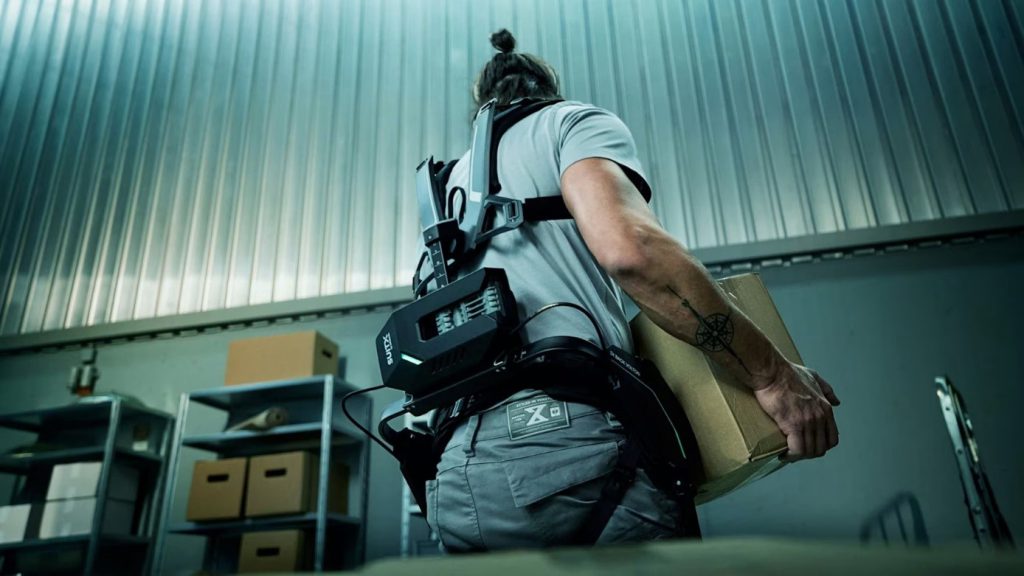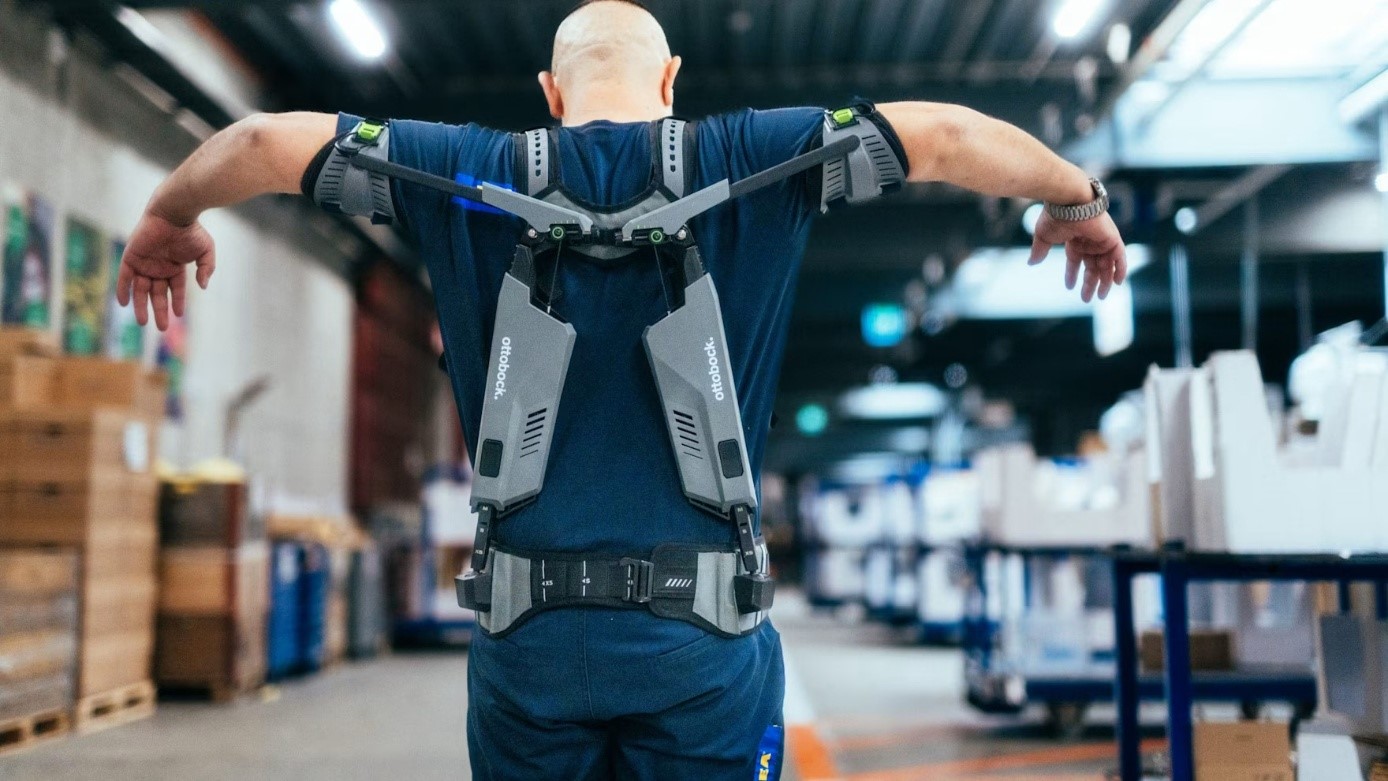Industrial and logistics jobs are undergoing rapid transformation. Rising production volumes, record e-commerce demand, tighter delivery expectations, and increasing process complexity are pushing workers and operations harder than ever before. At the same time, the availability of skilled manual labor is shrinking, absenteeism is rising, and musculoskeletal injuries continue to be one of the most persistent challenges in both logistics and manufacturing.
In this landscape, companies face a clear challenge:
How do you protect workers, maintain productivity, and ensure long-term operational stability in an environment built on physically demanding tasks?
Exoskeletons have emerged as one of the most promising answers. What was once a futuristic concept is now a practical, widely tested and rapidly adopted ergonomic solution that helps workers perform physically intensive tasks more safely, more efficiently, and with significantly less strain.
Importantly, exoskeletons are not about replacing people. They are about augmenting human capability, supporting healthy movement patterns, reducing injury risks, and making industrial work more sustainable for both workers and organizations.
Why Exoskeletons Matter Today
The rise of exoskeletons is driven by several powerful industry-wide trends.
Declining workforce availability
Warehousing, manufacturing, and logistics are facing chronic labor shortages. Fewer people are willing or able to perform physically demanding roles long term, and competition for reliable workers is intense. Companies increasingly need ways to protect and retain the talent they have.
Increase in musculoskeletal disorders (MSDs)
Injuries resulting from repetitive lifting, bending, twisting and overhead work remain one of the biggest causes of absenteeism and long-term health complications. Research shows that repetitive movements and improper lifting patterns are among the most common contributors to MSDs.
Pressure to increase productivity
With rising operational demands and tighter deadlines, companies must process more work with fewer people. The ability to support workers physically without slowing down operations becomes essential for maintaining throughput and consistency.
Growing focus on ergonomics and employee well-being
Modern organizations understand that ergonomics is not only about compliance. It is a strategic advantage. Better workplace ergonomics lead to lower turnover, fewer injuries, improved morale, and a stronger employer brand.
Exoskeletons directly address all of these challenges, making industrial work safer, more sustainable, and more resilient.
What Exactly Is an Exoskeleton?
An exoskeleton is a wearable biomechanical device designed to assist workers during physically demanding activities such as lifting, bending, squatting, carrying loads, or performing tasks above shoulder height.
Unlike traditional protective equipment, which only minimizes injury after strain occurs, an exoskeleton actively reduces load on the body while the task is being performed.
Its design allows it to:
- reduce the forces acting on muscles, joints, and the spine
- redistribute load from the body to its mechanical structure
- improve postural stability during demanding or repetitive movements
- increase endurance and reduce fatigue during long shifts
- support natural, unrestricted range of motion
Workers often describe the sensation not as being pushed, but as feeling more stable and less exhausted throughout the shift.
According to independent biomechanical studies, advanced exoskeletons can reduce muscle activation in high-load regions by 40-60%, significantly lowering strain and improving long-term endurance.
How Exoskeletons Work: The Biomechanics Behind the Support
Behind their simplicity lies a sophisticated integration of biomechanical and mechanical principles. Modern exoskeletons follow the body’s natural movement patterns while reducing strain in critical zones.
They achieve this through four core mechanisms:
Load redistribution
The external structure absorbs part of the physical load that would normally be carried by a worker’s muscles or spine. This reduces compressive forces on the lower back and decreases fatigue in major muscle groups.
Targeted support in high-strain positions
Exoskeletons do not provide support constantly. They activate assistance in positions that place the greatest stress on the body, such as bending, lifting from low positions, or working overhead. This ensures maximum protection exactly when workers need it.
Natural, intuitive movement
Through mechanical joints or sensor-driven systems, the exoskeleton synchronizes with the user’s movements. It does not restrict range of motion, allowing natural flexibility and quick adaptation to varied tasks.
Reduced fatigue and greater endurance By lowering continuous muscle activation, workers maintain precision, stability, and pace longer throughout the shift. This leads to fewer errors, greater consistency, and a better physical condition at the end of the workday.
Passive and Active Exoskeletons
Exoskeletons generally fall into two categories, each suited for different environments and intensity levels.
Passive exoskeletons

Passive exoskeletons use mechanical elements such as springs, elastic components, dampers, and levers. They require no battery power and provide support through stored mechanical energy.

Benefits include:
- low weight
- high reliability
- minimal maintenance
- suitability for all-day use
They are especially popular in warehouses, logistics centers, automotive assembly, and manufacturing lines where movements are repetitive but continuous productivity is essential.
Active exoskeletons

Active exoskeletons use electric motors, powered joints, sensors and smart control units to dynamically adjust assistance in real time. They provide stronger, more precisely targeted support, especially during heavy or high-frequency lifting tasks.
They are increasingly implemented in high-intensity industrial environments, including heavy manufacturing and construction.
Benefits for Workers and Employers
Benefits for workers
- significantly reduced strain on back, shoulders and joints
- improved stability and support during demanding tasks
- sustained performance throughout long shifts
- reduced fatigue and fewer repetitive stress injuries
- improved long-term well-being
Benefits for employers
- fewer workplace injuries and lower associated costs
- reduced absenteeism and workforce turnover
- improved productivity and throughput
- more predictable staffing and operational stability
- stronger positioning as a company that invests in employee safety and well-being
In industries defined by labor shortages and high physical demands, this can become a key competitive advantage.
More about the transformational potential of exosystems: https://newswire.ciras.iastate.edu/2024/03/14/empowering-workforces-the-transformative-potential-of-exoskeletons-in-industry
Conclusion
Exoskeletons represent a meaningful shift in how companies approach physically demanding work. They bridge the gap between the operational demands of modern industry and the physical limitations that often lead to injuries, fatigue, and instability.
By reducing strain, enhancing safety, and supporting long-term worker health, exoskeletons are becoming one of the most valuable tools for building a safer, more efficient, and more sustainable industrial workplace.
If your organization is considering ergonomic improvements or wants to test exoskeletons in a real operational environment, feel free to reach out to us. We can guide you through evaluation, selection, and implementation to ensure the best fit for your needs.
Our next article will dive deeper into real-world warehouse scenarios and measurable before-and-after results of exoskeleton implementation.






